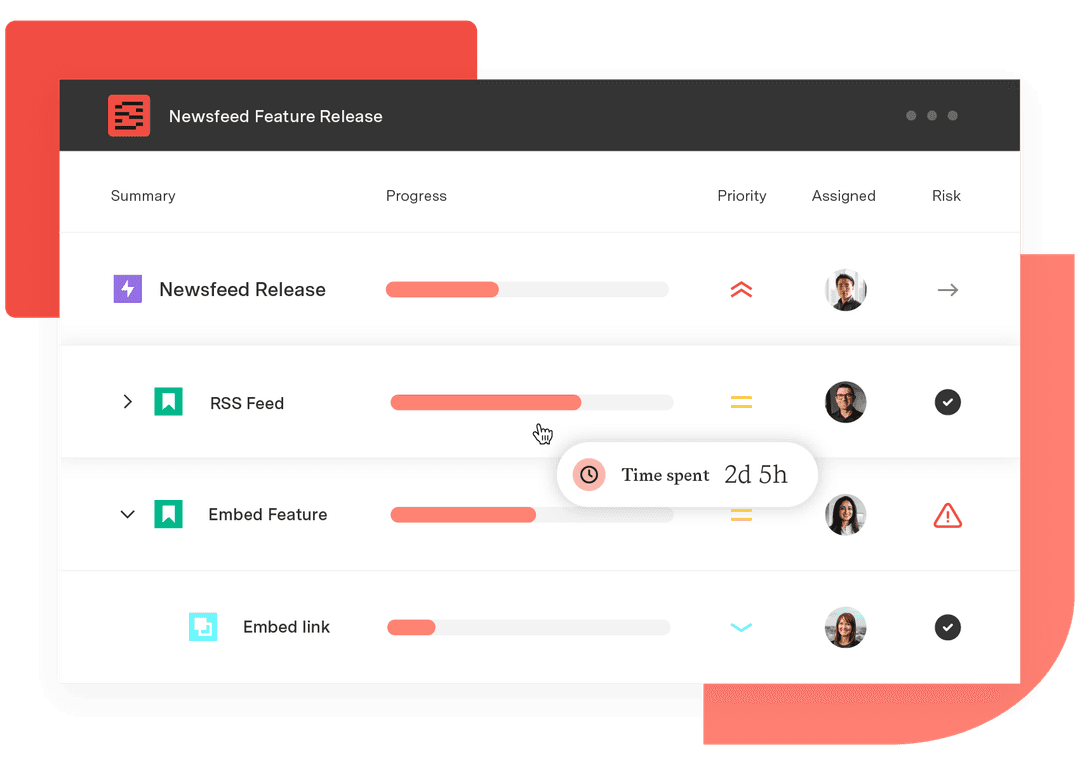Clarity, control, and consistency at scale: Implementing world-class program management
Tempo Team
It’s easy to understand the advantages of program and portfolio management: Visibility, dependency control, resource alignment.
Now comes the practical question: how do you actually implement these capabilities in your organization? It all comes down to people, processes, and tools.
People: Engage with all strategic delivery stakeholders, collaborate across all functions and work areas; provide purpose and context, align skills, experience, and tasks.
Processes: Standardize approaches, but remember that one size doesn’t fit all; provide flexibility and empower within guardrails; commit to continuous improvement, manage resource capacity more effectively.
Tools: Enterprise solutions to solve enterprise problems, integrations across all functions and work methods, world-class reporting, analytics, and communication, improve visibility into complex resourcing.
This is where most organizations struggle. Good intentions meet complex realities. Pilot programs succeed but fail to scale. Teams resist new processes that feel like additional overhead rather than helpful tools.
Here, we’ll show you how to bridge that gap using Tempo's integrated toolkit. We'll walk through five implementation areas that transform program management theory into practice.

Start with the foundation: Consistent data and hierarchical views
Before you can manage programs effectively, you need to see them clearly. The Tempo Project Collection lets you track effort, cost, and finances – right where the work is done in Jira. These tools are modular, meaning they can be deployed on a team-by-team basis, following their existing processes and best practices, while creating a consistent data layer across a complete program.
Track, plan, and optimize time and capacity directly in Jira.
See the Project CollectionThe Program Collection adds Capacity Planner and Structure PPM, the leading Jira tool for portfolio roll-up views and custom hierarchies. This uniquely equips you with a full view of capacity and interdependencies between multiple projects.
Organize and manage complex programs with clear, consolidated views.
See the Program CollectionWith Custom Charts, you’re able to track real-time progress on work, apply filters, identify blockers, and gain a unified view across the entire program.
This foundation of standardized data and program hierarchy views enables everything else. It enables you to surface big-picture insights, understand all work in progress, and adapt quickly when priorities shift.
1. Visualize dependencies with Gantt charts, baselines, and dependency tracking
Once your hierarchical structure is in place, you need to make program dependencies visible and manageable. This is where many program management efforts fail – dependencies remain invisible until they cause problems.
This is where Gantt Charts for Structure PPM brings key functionality. Gantt charts transform dependency relationships into visual timelines that show exactly how to balance resources. You can see the critical path lies and where to build in buffer time.
Milestone management ensures critical handoffs stay visible across your program timeline. With Structure Formulas, you can build in powerful automation that makes handoff simple.
Implementing dependency management without overwhelming teams
The challenge is capturing dependency information without creating administrative overhead that slows teams down.
Start with the dependencies that matter most – critical path items that directly impact delivery dates. Not every connection between projects needs formal tracking, but the ones that determine program success do.
Involve team leads in identifying these critical dependencies. They understand the technical and logistical relationships that might not be obvious to program managers. This bottom-up input ensures your dependency model reflects reality.
Use milestone-based dependency tracking rather than task-level connections for most relationships. This reduces maintenance overhead while keeping the most important coordination points visible.
2. Scale consistency with project templates and permissions management
"Tempo's Program Collection provides a single source of truth that gets teams aligned and reduces complexity. I's a game changer to have hierarchy views, formulas, and automations that connect every moving part." – Paulo Bonamigo, Sales Manager at e-Core.
Once you’ve refined your processes, they can be built into project templates that allow you to speed up delivery at a program-wide scale.
It’s important to keep in mind that teams need flexibility to follow their own ways of working while contributing to program-level visibility and control.
Template development should involve representatives from different team types. Engineering teams might need different custom fields than marketing teams, but both need to report progress and risks in ways that roll up to program dashboards.
Permissions management ensures the right people have access to appropriate information without compromising security or creating information overload.
3. Optimize allocations with capacity planning
Resource constraints determine what's possible in your program portfolio. Tempo Capacity Planner integrates with your program hierarchy and project structures to provide portfolio-level resource visibility and optimization.
The integration between Capacity Planner and Structure PPM means your capacity analysis uses the same project structures and assignments that drive your program management. You're not maintaining separate systems with different assumptions about who's working on what.
Scenario modeling becomes possible when capacity data integrates with program timelines. You can evaluate different resource allocation approaches and their impact on delivery dates before making commitments – and then adjust in real-time as sprints or quarters progress.
4. Enable stakeholder alignment with real-time reporting
Different audiences need different views of the same underlying information.
Tempo Custom Charts for Jira transforms the data captured in your program hierarchy and capacity planning into stakeholder-specific dashboards and reports.
Executive dashboards focus on portfolio-level progress, budget consumption, and strategic risk indicators. They provide the high-level perspective needed for strategic decision-making without overwhelming detail.
Program manager dashboards emphasize resource allocation, dependency status, and tactical coordination needs. These support day-to-day program management decisions and cross-team coordination.
Team lead dashboards highlight individual team performance, capacity utilization, and immediate blockers. These help teams stay focused and productive within the broader program context.
Automated reporting reduces the time spent gathering and formatting status information.
5. Building implementation momentum
Successful implementation requires systematic rollout that builds capability incrementally while delivering value at each stage. You can't implement all five areas simultaneously, but you need a clear path toward integrated program management:
Centralize planning, approvals, communication, portfolio management.
Standardize workflows, decision making, and work delivery.
Integrate planning and delivery, change management, and technology platforms.
Validate forecasts, plans, and change impacts.
Adjust and align objectives to investments, investments to work, and work to objectives – continuously.
Start with consistent data input, hierarchical structures, and basic program visibility. This foundation enables everything else and provides immediate value to program stakeholders. Teams can see how their work contributes to larger outcomes.
Add dependency tracking for your most critical programs. Focus on the handoffs and coordination points that currently cause problems. Success here builds confidence in expanding dependency management to other programs.
Integrate capacity planning once your project structures are stable. This requires accurate project assignments and time allocation, which builds on your foundational hierarchy work.
Expand template usage and permissions management as you scale to more programs. These capabilities become more valuable as your program portfolio grows.
Implement stakeholder reporting and dashboards continuously throughout the rollout. Regular communication about implementation progress and early wins maintains organizational support for the transformation.
The result is program management capability that creates clarity from complexity, control from chaos, and consistency from diverse team practices. That allows you to make smart decisions at the portfolio level and adapt your strategy with confidence.
Sign up for a demo
Register













































